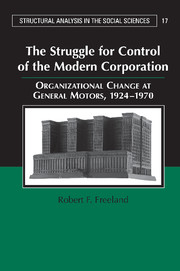 The Struggle for Control of the Modern Corporation
The Struggle for Control of the Modern Corporation Book contents
- Frontmatter
- Contents
- List of Figures and Tables
- Acknowledgments
- 1 The Modern Corporation and the Problem of Order
- 2 Creating Corporate Order: Conflicting Versions of Decentralization at GM, 1921–1933
- 3 Administrative Centralization of the M-form, 1934–1941
- 4 Participative Decentralization Redefined: Mobilizing for War Production, 1941–1945
- 5 The Split between Finance and Operations: Postwar Problems and Organization Structure, 1945–1948
- 6 Consent as an Organizational Weapon: Coalition Politics and the Destruction of Cooperation, 1948–1958
- 7 Consent Destroyed: The Decline and Fall of General Motors, 1958–1980
- 8 Conclusion
- Appendix: General Motors' Financial Performance, 1921–1987
- References
- Index
5 - The Split between Finance and Operations: Postwar Problems and Organization Structure, 1945–1948
Published online by Cambridge University Press: 05 August 2011
- Frontmatter
- Contents
- List of Figures and Tables
- Acknowledgments
- 1 The Modern Corporation and the Problem of Order
- 2 Creating Corporate Order: Conflicting Versions of Decentralization at GM, 1921–1933
- 3 Administrative Centralization of the M-form, 1934–1941
- 4 Participative Decentralization Redefined: Mobilizing for War Production, 1941–1945
- 5 The Split between Finance and Operations: Postwar Problems and Organization Structure, 1945–1948
- 6 Consent as an Organizational Weapon: Coalition Politics and the Destruction of Cooperation, 1948–1958
- 7 Consent Destroyed: The Decline and Fall of General Motors, 1958–1980
- 8 Conclusion
- Appendix: General Motors' Financial Performance, 1921–1987
- References
- Index
Summary
The postwar era brought unprecedented opportunities for profit and expansion in the automobile industry. Because no new cars had been produced for civilian use during the United States' participation in the war, there was an enormous pent-up demand for new automobiles that would remain unsatisfied until 1949. Over the long run, the decade following the war also saw significant growth in consumer income and purchasing power, further stimulating demand and ultimately leading to the production of larger cars with more accessories and higher profits per unit. These trends would put the automobile industry at the center of postwar growth in the American economy. But before long-range prosperity could be realized, a number of difficulties and uncertainties had to be resolved.
The most immediate problem facing GM and other automobile producers was the process of reconversion itself. Victory over Japan was accompanied by “an avalanche of contract terminations amounting to approximately $1.75 billion of war orders.” Government-owned inventories, equipment, and machinery had to be removed from GM's plants, generating some 17,000 freight-car loads of material. After being stripped down, existing plants had to be redesigned and refurbished with new equipment, and many new plants were built to increase productive capacity. Reconversion and expansion had to be carried out under conditions of high inflation, shortages of critical materials, and governmental controls that set prices and limited access to steel and other critical supplies. A number of strikes also interrupted production both inside and outside of GM.
- Type
- Chapter
- Information
- The Struggle for Control of the Modern CorporationOrganizational Change at General Motors, 1924–1970, pp. 175 - 222Publisher: Cambridge University PressPrint publication year: 2000


